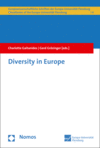Zusammenfassung
Die Vielfalt der Perspektiven, Verhaltensweisen und Einstellungen gewinnt im Rahmen der fortschreitenden Europäisierung eine immer größere Bedeutung. Das Buch untersucht das Thema der Vielfalt in Europa in seinen interdisziplinären Bezügen. Um das Konzept der Vielfalt in ihrer Komplexität erschließen zu können, ist eine vielschichtige Betrachtung notwendig. Vielfalt im europäischen Kontext lässt sich in vier wesentliche Bereiche untergliedern. Der erste Abschnitt des Buches beschäftigt sich mit dem "Anderssein" und betrachtet hierbei auch die verschiedenen Probleme der Minderheiten in Europa. Das zweite Kapitel untersucht die interkulturelle Debatte in ihrer theoretischen Bedeutung und ihren Auswirkungen auf den Innovationsprozess. Der dritte Abschnitt behandelt die verschiedenen Stufen der Zusammenarbeit, wie bspw. transnationale Organisationen. Das letzte Kapitel untersucht die verschiedenen kofinanzierten kulturellen Projekte in der EU, vor allem in Bezug auf territoriale Aspekte.
Mit Beiträgen von:
Laura Asarite,Vita Balama, Gerhard Besier, Jutta Bissinger, Jaume Castan Pinos, Ilona Ebbers, Gerd Grözinger, Elisabeth Keller, Tove Malloy, Mirjam Monteiro, Erma Mulabdic, Elzbieta Opilowska, Katarzyna Stoklosa, Monika Sus, Hanna Vasilevich
Abstract
As Europeanisation flourishes, the importance of diverse perspectives, attitudes, and approaches becomes increasingly pertinent. This book explores the interdisciplinary nature of diversity in Europe. In order to truly understand the complexities of the diversity phenomenon, it is necessary to explore this concept under the scope of many different disciplines. Thus, the concept of diversity is examined through four main sections. The first part of the book covers the notion of "otherness" and surrounds different topics of minority issues in Europe. The second section examines the intercultural debate in both a theoretical sense and its affect on the innovation process. The third section explores different levels of cooperation, such as transnational organizations and through Europeanisation. The fourth and final section covers different co-financed cultural cooperation projects in the EU, specifically in regard to territorial issues.
With contributions by:
Laura Asarite,Vita Balama, Gerhard Besier, Jutta Bissinger, Jaume Castan Pinos, Ilona Ebbers, Gerd Grözinger, Elisabeth Keller, Tove Malloy, Mirijam Monteiro, Erma Mulabdic, Elzbieta Opilowska, Katarzyna Stoklosa, Monika Sus, Hanna Vasilevich
- 237–240 About the Authors 237–240

